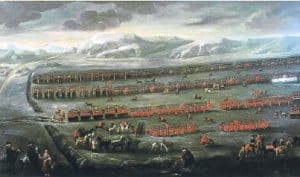The Battle of Sheriffmuir 1715
The 1715 Jacobite Rebellion, sometimes referred to as the ‘Great Rebellion’, represented the third and by far most serious threat to the Government and crown since the usurpation and exile to France of James VII & II by William and Mary in the ‘Glorious Revolution’ of 1688. It did not take long for the supporters of James, who called themselves Jacobites after the Latin for that name, to take up arms in Scotland on behalf of the ‘king across the water’.

The Battle of Sheriffmuir 1715
The battle of Sheriffmuir is significant as the only major engagement in Scotland during the 1715 Jacobite Rising. The battle was a chaotic affair, with the outcome very much debatable, but it was sufficient to bring an end to the rising. It also involves one of the largest Jacobite armies ever fielded in Scotland, with only Falkirk in 1746 exceeding it.
After the death of James’s eldest surviving daughter, Queen Anne, in 1714, the throne was taken by George of Hanover, leaving the House of Stuart with a weakened claim to the throne. The Earl of Mar began a renewed uprising with the raising of the Scottish standard in September 1715. After gathering their forces in Perth the Jacobites advanced southward, sending a separate force into England via Edinburgh. Mar’s army met the Government’s smaller force on the high ground to the east of Dunblane.
The Jacobite force was a mixed body of Highlanders and Lowlanders, with the main body composed of the former. Both came from different military traditions and these were to be displayed on the battlefield, with the charge by the Highlanders on the right and the delivery of volley fire by the Lowlanders on the left flank.
The Jacobite army was far larger, estimated at 807 horse with 6,290 foot. However, the quality of the troops was far lower than the seasoned veterans on the Government side. Many of these troops had no previous experience of combat. Additionally, Mar was not an experienced military commander and relied on advice from a small group of trusted senior officers, several of whom had seen service on the continent.
In contrast, the smaller Government army was relatively well-experienced and comprised both Scottish and English units, and in Argyll, they had a seasoned commander. The Government army consisted of over 3,000 men, which has been defined as 960 dragoons with 2,200 infantry.
Argyll had drawn up his army in two lines, with a squadron of the Scots Greys on the right and Evan’s Dragoons next to them.
General Evans led his own regiment (Evan’s Dragoons) in the charge, with Lieutenant-Colonel Hawley behind him. The Scots Greys, who were on their right, were immediately successful, driving the Jacobite Horse before them. Evan’s rode against two regiments of Foot and were received with such hot fire that they were checked and thrown back. General Evans had his horse killed under him and Hawley was shot through the shoulder.
The regiment rallied, however, and returned to the charge, got among the enemy foot and, after a spell of furious hand-to-hand fighting broke them and sent them flying. They pursued the enemy for two miles, giving them no quarter. Finally, the regiment, which had joined up with the Greys, pulled up at the River Allen.
The regiment was much commended for its spirited fighting in all the reports of the day. It had lost one cornet and four troopers killed, and the Colonel, the Lieutenant-Colonel and Captain Farrar were wounded.
The outcome of the battle was to be inconclusive, with both sides claiming victory. However, Mar’s failure to secure a decisive victory and take control of central Scotland meant defeat for the uprising. This was further secured the following day by the surrender of the Jacobite forces in England.
The arrival in Scotland of the deposed James Stuart in December could not turn the tide and the 1715 Rising ended with the exile of Mar and the execution of a number of key English Jacobites. Although the Jacobites were beaten, they were unbowed and the next rising happened just four years later.

